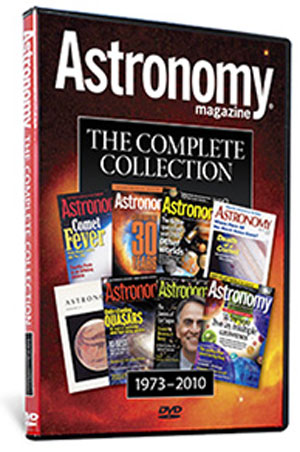 I’ll be sharing the history of the magazine from time to time, a little at a time, in this blog. It’s a fascinating story that has witnessed astronomy grow in leaps and bounds as our understanding of the cosmos has deepened. And you can capture the whole history of the magazine on DVD for your computer — every page of every issue, 449 issues and more than 46,000 pages altogether.
I’ll be sharing the history of the magazine from time to time, a little at a time, in this blog. It’s a fascinating story that has witnessed astronomy grow in leaps and bounds as our understanding of the cosmos has deepened. And you can capture the whole history of the magazine on DVD for your computer — every page of every issue, 449 issues and more than 46,000 pages altogether.
The DVD also includes the entire histories of Deep Sky and Telescope Making magazines, two quarterlies published by Astronomy, 23 special issues published over the past 15 years, and other special features. It comprises a gold mine for anyone interested in astronomy. Check it out here.
As background, here’s the story of Astronomy magazine in 1974:
Astronomy’s first full year was a time of growth for the magazine, and for its publisher to slowly experiment with a formula he was happy with. The issues mostly remained at 64 pages (although one swelled to 80), the content a blend of astronomy, cosmology, planetary science, observing, imaging, and telescopes. By year’s end, the magazine’s fledging circulation reached 30,000 and ad pages grew, giving Steve Walther the freedom to plan for bigger things to come. Many highlights appeared throughout the year. They included Fred Whipple writing about comets, an interview with black hole theorist Kip Thorne, Carl Sagan on the “canals” of Mars, Sagan on the “lost pictures” of Mars, Ben Bova on pseudoscience, and Isaac Asimov on Alpha Centauri.
The magazine’s growing popularity necessitated a larger staff, so the company added Canadian science writer Terence Dickinson as editor, with Walther’s title morphing to editorial director. The magazine’s catchy tagline, “The World’s Most Beautiful Astronomy Magazine,” splayed prominently on the table of contents, betraying a growing presence of sensational artwork in a day when close-up views of many of the prominent article subjects simply did not yet exist, either by space probe or the Hubble Space Telescope. Vic Costanzo and others regularly contributed artwork, and major names that would transform astronomical art — Don Dixon, Mark Paternostro, Adolf Schaller, and Rick Sternbach — were starting to appear in print. The fabulous scenes of artwork — “man’s dreams of worlds unseen” as Walther used to say — were starting to become a hallmark of the magazine.
Astronomer Gerrit L. Verschuur began contributing more advanced pieces about astrophysics under the heading “Stellar Frontiers”; Jack Newton and Leo C. Henzl, Jr., wrote about astrophotography; and Thomas C. Bretl highlighted a constellation in every issue. One lowlight came along in December 1974 when Dickinson, as editor, penned a story that seriously examined the supposed UFO-abduction story of Betty and Barney Hill in “The Zeta Reticuli Incident.” The Hills had allegedly drawn a star map from memory based on seeing our solar system from the perspective of this nearby star, Zeta Reticuli. The fact that the magazine covered such an absurd thing set back the credibility of the title for a while, and Dickinson left in mid-1975. (Staff members at the magazine later referred to this legendary story as “The Zeta Ridiculi Incident.”)